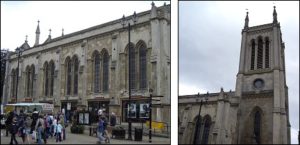 The medieval church was a mid 12th century foundation, which mostly survived until 1832. It seems to have been extensively altered in the 15th century, and was again modernised in the 17th century. There was rebuilding of the east end in 1707. The wooden tower probably dates from this time. Writing in 1709, Peck says that the tower is sensibly seen to shake when the Bells do ring.
The medieval church was a mid 12th century foundation, which mostly survived until 1832. It seems to have been extensively altered in the 15th century, and was again modernised in the 17th century. There was rebuilding of the east end in 1707. The wooden tower probably dates from this time. Writing in 1709, Peck says that the tower is sensibly seen to shake when the Bells do ring.
Poem published in ‘The Gentleman’s Magazine’ of April 1761:
On the Design of pulling down the Wooden Tower of St. Michael’s Church in Stamford, and building a steeple of stone:
Do you call this a church? Why the tow’r’s made of wood,
I’m sure such a church can produce nothing good.
Then away with this wood for a steeple of stone,
Our fathers were wooden contrivers we own.
But we are grown wiser – have money to spare,
Be the charge what it will we do not much care.
It will shew the whole town what we’d have understood,
That we are, or at least would be thought, to be good,
But soon the poor parson we’ll leave in the lurch,
tho’ we build up the steeple, we’ll ne’er go to church.
This wooden structure was replaced in stone in 1761.
In July 1831 the Rev. Charles Swann became the Rector of St. Michael’s, and later that year had plans to re-pew the church, which went ahead in April 1832. In June 1832, attempts were made to improve the church under the supervision of John Boyfield Ill, by the removal of alternate pillars.
On 8th June 1832 St. Michael’s church collapsed.
Naturally there was much discussion and argument after the collapse of St. Michael’s. In the Stamford Mercury of 7th September 1832, the question was asked, who to be charged with rebuilding the church – the parish, or the Rev. Swann, since it had been his idea to remove the pillars in the first place? In order to salvage something from the ruins, the sale of 20 tons of lead and oak beams was ordered by the churchwardens.
There were various estimates of cost of rebuilding: £3,560, £4,000, £1,500. Many subscriptions were collected towards the rebuilding fund, but a lot of bitterness developed between the rector and his parishioners. The Mercury reported in 1833 that a vestry meeting broke up without proceeding to business in consequence of a most indiscreet and offensive publication which had been made, and which is attributed to the Rector and not denied.
In the Stamford Mercury of 15th August 1834, it was reported that a ‘Venerable’ lady of Stamford had lived to see rebuilding of St. Michael’s tower in 1761, and the taking down of the same in 1832.
17 different plans were submitted for the rebuilding, and the architect eventually chosen was John Brown of Norwich, at a cost of £2,800. The Early English style design included a large gallery. Early in 1835 ‘active operations’ for rebuilding were begun by Messrs. Woolston (mason) and Collins (carpenter), and in October 1836 the re-consecration service was held, attended by the Bishop of Lincoln and 70 clergy.
In 1838 the Rev. Swann died, aged 41, and shortly after the Mercury reported that the new rector ‘received the unpleasant information that the late rector died insolvent and that there is a charge of £520 against the living for dilapidations! This is equal to 4 years’ income of the preferment’.
In 1962, St Michael’s Church was closed, and remained so and unused for 20 years, during which time vandals succeeded in destroying many of the church fittings still remaining.
In 1981, the building was sold. There had been much discussion locally as to the best use for the building; and old people’s home, an arts centre, a shopping arcade, had all been mooted.
The building now houses 2 shops, a building society, and an insurance company in the tower.